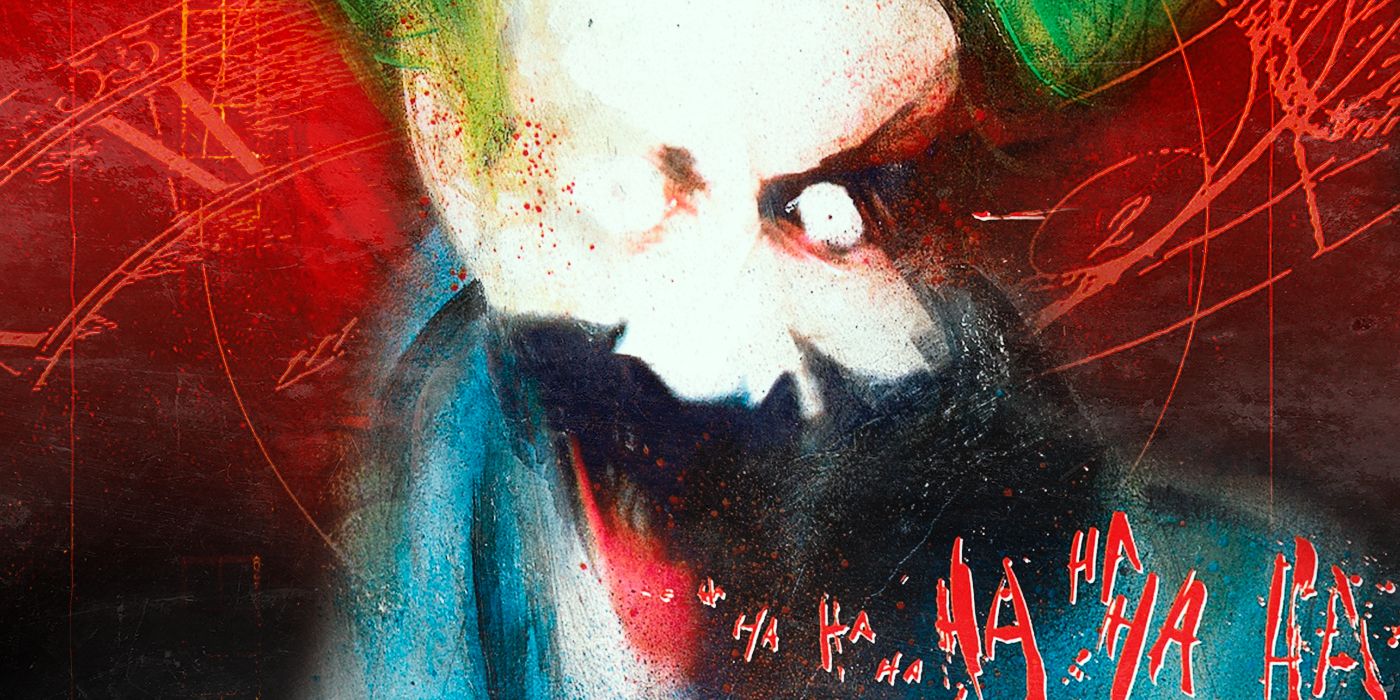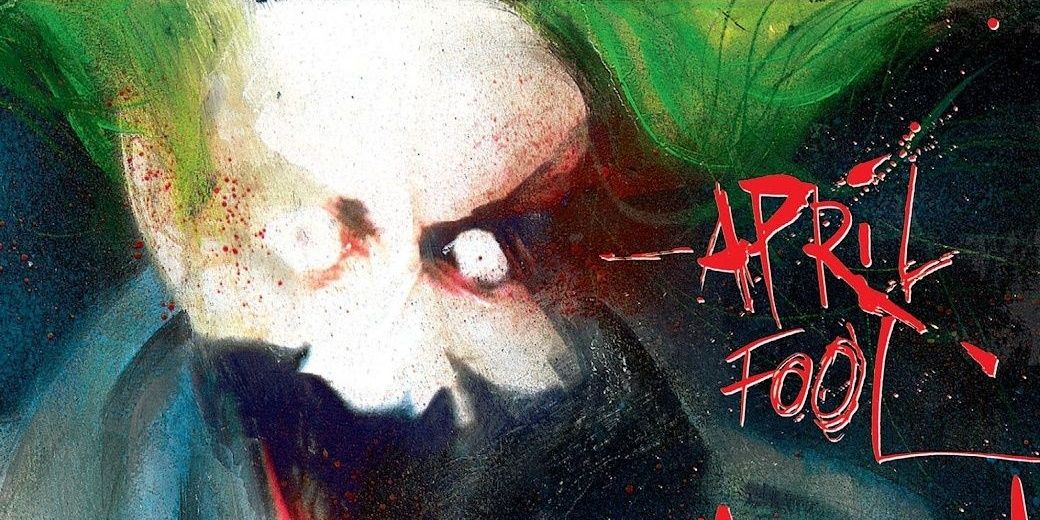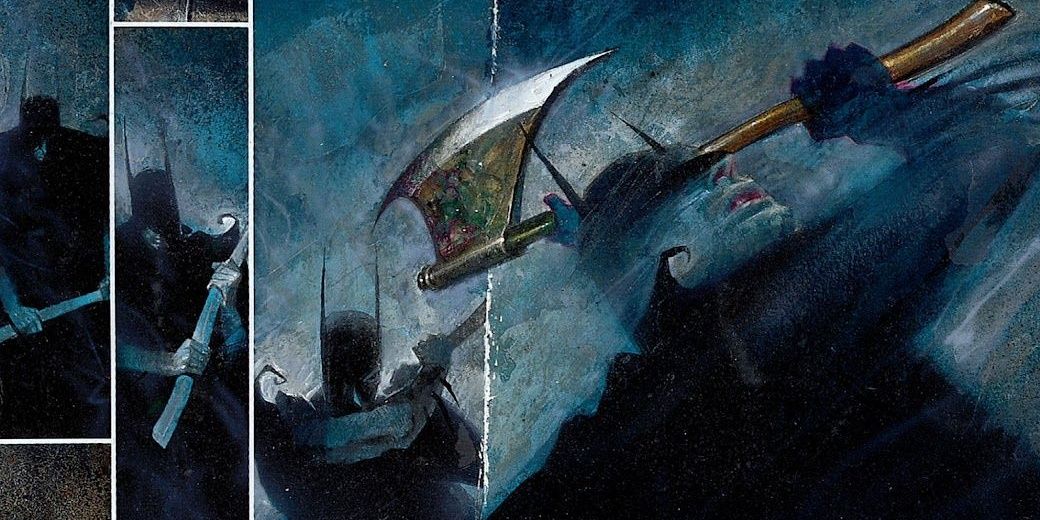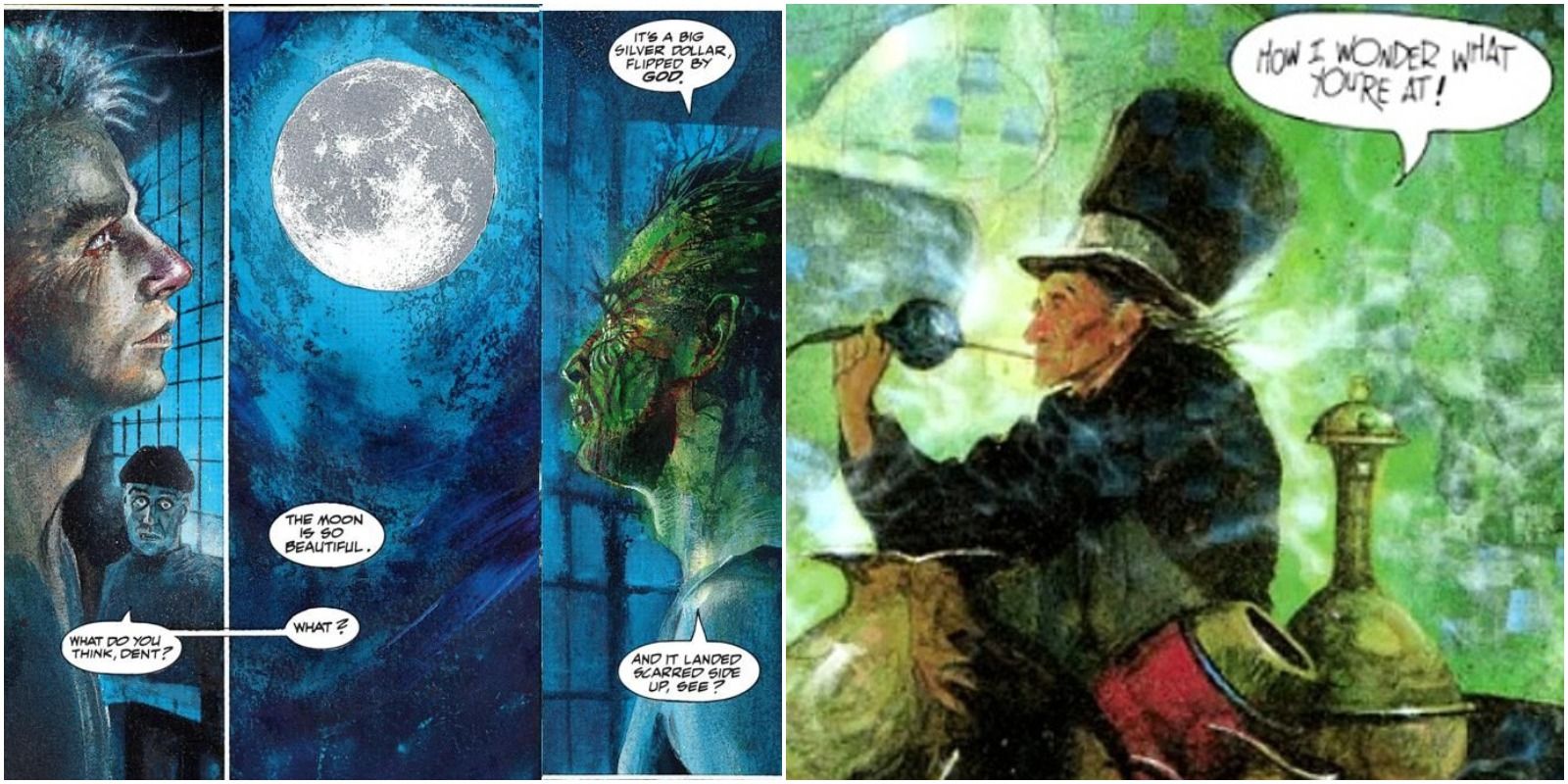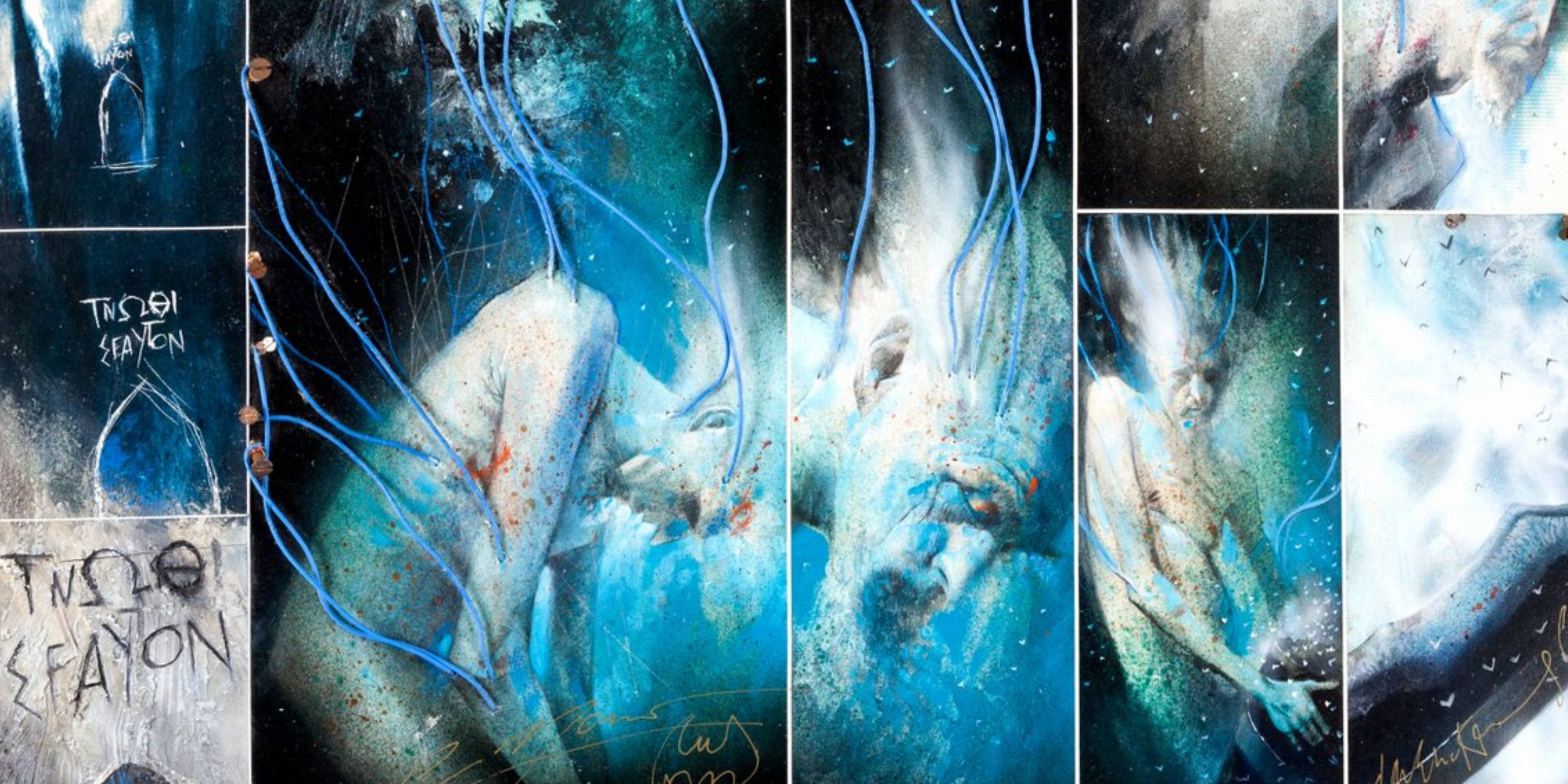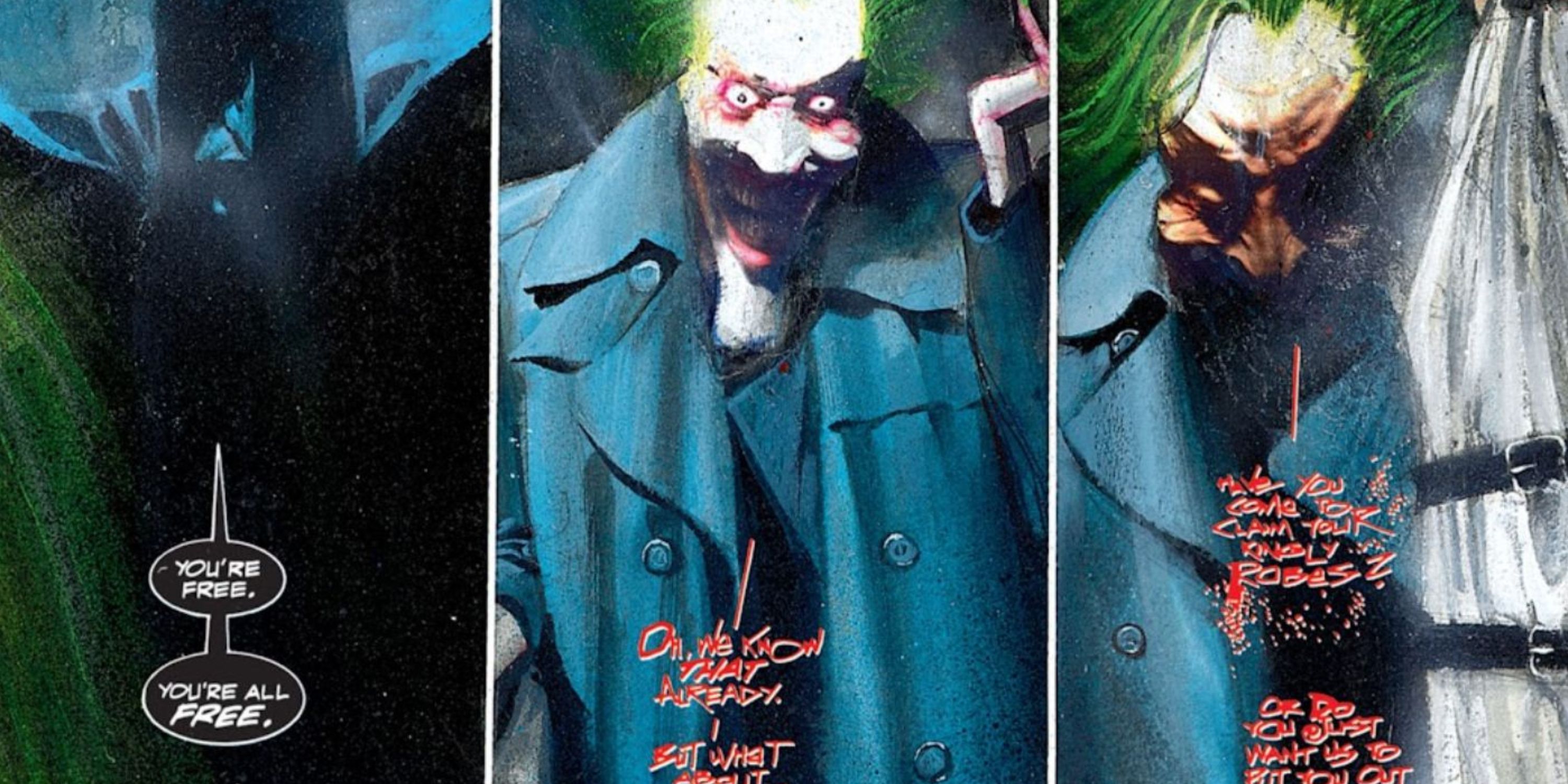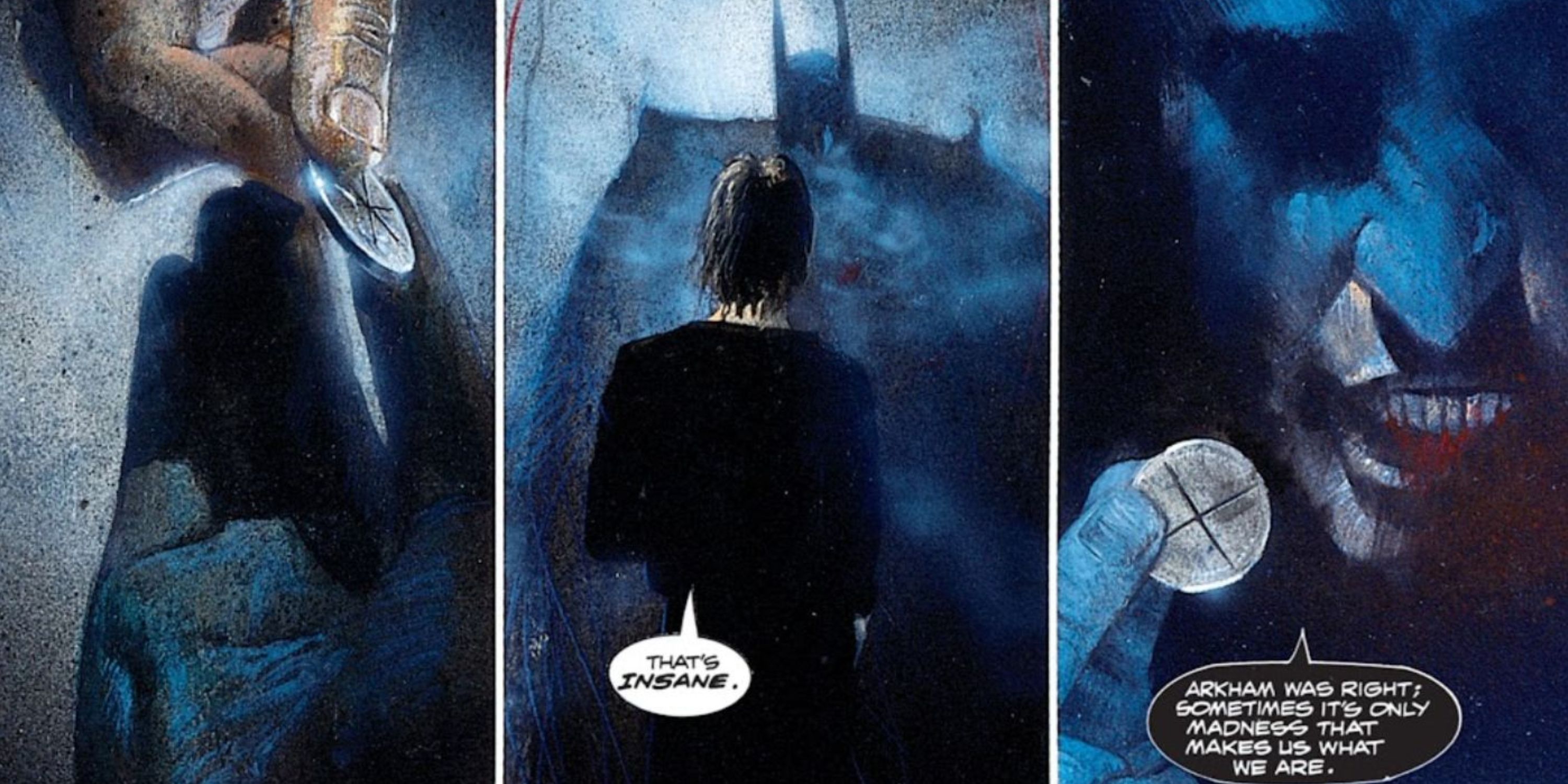This article is part of CBR's 31 Days of Halloween Event. Read the rest here!
Batman lends himself well to horror stories. Bruce Wayne chose a bat because criminals were a cowardly and superstitious lot; fear is baked into the character's DNA. There have been many Batman horror stories over the years, but one stands above the rest for many Batman fans: Batman: Arkham Asylum: A Serious House On Serious Earth. The book was part of DC's full court press of Batman media during the height of Batmania around the release of the Tim Burton Batman movies.
A Serious House On Serious Earth, by Grant Morrison, Dave McKean, and Gaspar Saladino, takes Batman into Arkham Asylum during a hostage situation. However, fans just expecting a story where Batman is surrounded by enemies and fights his way out to free the hostages are in for a surprise. Batman has some dark stories, but this one takes the cake for a multitude of reasons. All of these add up to give readers the perfect horror story.
A Murderer's Row Of Talent
Arkham Asylum: A Serious House On Serious Earth is completely dependent on the event known DC's British Invasion. English writer Alan Moore had made a splash writing Swamp Thing for editor Karen Berger, so Berger, editor/artist extraordinaire Dick Giordano, and the head of DC Jeanette Khan went to England to find more talent. The British comic industry comprised creators doing sci-fi and fantasy serials for comic anthologies like 2000AD and Warrior, all of whom had a more mature sensibility than American creators. DC's British Invasion created legends. The first round of creators included Neil Gaiman, Grant Morrison, Dave McKean, and Peter Milligan, who all found their way onto books that became massive hits. Gaiman and McKean started out with Black Orchid, and would pitch The Sandman together. McKean worked on The Sandman's covers — multimedia creations that mixed traditional pencil and ink art with paintings and handmade props. Morrison would write Animal Man, a book that demonstrated their ability to find new ideas within old concepts.
The British Invasion coincided with 1989's Batman. That movie was a cultural phenomenon and DC took advantage of that. 1989 brought fans several big Batman projects, like Batman: The Killing Joke. Arkham Asylum was meant to get Morrison and McKean's names out there, attaching them to a project that was sure to sell like hotcakes. The book was a wild success. Comics had become a more mature medium since 1985's Watchmen and The Dark Knight Returns. Arkham Asylum found an audience who not only wanted more Batman, but wanted a Batman who wasn't the silly '60s version. There was nothing silly about Arkham Asylum, and the story has gone down as something special even among Batman tales.
Seriously Disturbing
Frank Miller's The Dark Knight Returns made dark Batman popular again, but even that story pales compared to Arkham Asylum. The Dark Knight Returns is still a traditional Batman story. Arkham Asylum takes a rather cliche Batman story and goes to places that few other Batman stories would ever attempt to. There are actually very few fights in this comic. The only one that really sticks out is the battle between Batman and Killer Croc, a violent, scary encounter that turns Killer Croc into a nigh-unstoppable dragon. In the hands of any other two creators, Arkham Asylum would have been a good story, but it would have been a story that readers had read a million times. There's nothing that interesting about the inmates escaping Arkham and taking hostages. However, Morrison and McKean took that tired idea and did something bold.
Grant Morrison earned a reputation for their revolutionary takes on DC characters. They've redefined multiple characters by finding angles no one else has seen before. Morrison accomplishes that with Arkham Asylum. A great thing about Morrison's takes on the villains in this book is that they remember many of Batman's villains have mental illnesses, and aren't just comic supervillains. For example, Mad Hatter does his whole Alice In Wonderland spiel, but there's a disturbing interlude in the middle about little blond girls that reminds readers this man isn't a whimsical eccentric obsessed with a classic book, he's a dangerous monster one second away from doing something horrible. Alice In Wonderland quotes bookend the comic, which makes sense for a book that takes Batman into a world of madness.
Arkham Asylum has been a part of great Batman stories often, and many times over the years people have called the Asylum cursed. This book digs into the history of the Arkham family, focusing on Amadeus Arkham, a man who has feared the madness that walked between the walls of his ancestral home. Arkham's diary plays an important role in the story, as readers witness the events that sent him on a downward spiral, that made him take his home and turn into a place for the mentally ill. It all sets an atmosphere for the reader, one that echoes Batman's own journey through the book. Morrison puts Batman and the readers through a labyrinth of darkness until they find the center of it all. It's a harrowing journey through the minds of villains readers know very well and the delusion that infected one man and destroyed his life. That Batman is taking this trip, another person gripped by chaos that destroyed his life, is all the better. Morrison weaves multiple layers of meaning throughout the book, examining each character and highlighting the darkness in all of them. Even the innocent become murderers in Arkham Asylum, infected by the ghosts of the house and the city that it exists in — the serious house on serious earth.
Morrison's writing is amazing, but this story just doesn't work at all without McKean's art and Saladino's letters. Lettering isn't something that readers consciously notice a lot of the time, but the way a letterer shapes words is very important to a story. Saladino gives the different characters completely different fonts, each one telling readers about how they sound. The Joker's font is jagged and variable in size, unrestrained by speech bubbles, allowing readers to imagine his voice as rough and constantly increasing and decreasing in volume. Batman's words are in black speech bubbles. Maxie Zeus's have an electric feel to them. Arkham's diary is written in an exact cursive that gives readers a look into his mind. The lettering of Arkham Asylum is gorgeous, and it enhances the reading experience. Saladino's letters are an art form unto themselves. DC could have gotten anyone to letter this book and it still would have been cool, but Saladino understood the assignment and gave readers letters that were as much an experience as any other part of the book.
McKean is a true artist's artist, and Arkham Asylum: A Serious House On Serious Earth shows why. Morrison's script is a hallucinatory masterpiece, but none of that works without the right artist and McKean is definitely the right artist. McKean didn't just draw the story, either. As a multimedia artist, he designed the entire book, from the dust jacket to the front and back cover. Lace is a common element throughout the book's art and the book's cover reflects that, capturing the patterned feel of lace in grey and black. There's a bat skeleton in the lower right corner of the front cover, and the first few pages of are just pieces of McKean's art. Reprints have taken away the lace patterned cover with the bat skeleton and the gorgeous dust cover, which is a shame because McKean's design for the original book is part and parcel of the book's presentation. While not having those elements doesn't hurt the story, being able to read it as it was meant to be read brings something extra to the story. It shows just how much thought was put into in this book. It's definitely worth hunting down one of the rarer early editions to get the full effect that the creators wanted readers to have.
McKean's art on Arkham Asylum: A Serious House On Serious Earth is breathtaking. To say that it's not traditional comic art is the most obvious statement that can be made. McKean's Joker, for example, is unlike any before or since and it perfectly captures the dark chaos and twisted nature at the heart of the character. McKean's Killer Croc is more of a monster than ever, which perfectly fits his role in the story. Clayface, Maxie Zeus, Two-Face, and Mad Hatter all look different than they have before and each design does half the work of storytelling. On top of that, McKean's art has textures to it, partly from the way he uses props in his artwork, and it brings things out in the art that just traditional painted and penciled art wouldn't. This is a dark book, in a very literal sense because black is the main color on every page, but it's never so dark that readers can't tell what's going on. The art creates an atmosphere that perfectly parallels the descent into darkness and depravity.
McKean's Batman is very interesting. Throughout the book, Arkham's twisted atmosphere starts to infect Batman, driving him further along the path that Amadeus Arkham walked before him. McKean's Batman is obscured in shadow, and sometimes is little more than a Batman shaped outline in the darkness, another ghost walking the halls of the doomed facility, his own pain adding to the psychic wound that Arkham Asylum represents. It's all just another way that Arkham Asylum's art communicates with the reader. The way McKean obscures figures to show their descent, or the way he illustrates the monsters within each character, tells so much of the story. Even if all the words were gone, readers would still feel the eerie darkness coming off the page.
Arkham Asylum shows how important the alchemy of the comic team is and how each of them works together. Morrison's script is amazing and creates the themes and ideas that drive the story's horror. Saladino's letters put the words into everyone's mouths, so that readers can hear characters' voices, the madness coming through in every sentence. McKean's art supplies the atmosphere and makes Morrison's ideas reality. Arkham Asylum is such a classic Batman horror story because of how well the entire team works together to make the story a reality. Batman lends himself well to psychological storytelling and Arkham Asylum uses that to its advantage. The team proves that the horror isn't that far under the surface in any Batman story and how the demons of the past can infect the present. There's a reason this book has survived as a best of all time Batman story and made Morrison and McKean wealthy when it first came out. It was able to burrow into readers' minds and stay there. As much as the characters find themselves affected by Arkham Asylum's grim atmosphere, they are as well.
We're All Mad In Here
Arkham Asylum: A Serious House On Serious Earth isn't the first Batman horror story, but it is the smartest in many ways. Morrison, McKean, and Saladino create a story that takes readers on a dark journey through Arkham. Arkham Asylum is like an onion, each layer taking readers deeper and deeper into its exploration of humanity at its worst. The center reveals the truth, but the problem is never solved. The madness is still there, bubbling behind the walls ready to devour everyone.
Arkham Asylum: A Serious House On Serious Earth holds something chilling on every page. It's a journey into darkness like no other in Batman history. Many stories took pieces of it and tried to take them further, but never had the impact of this one. It's a picture of the central tragedy of Batman comics, of an ever escalating plague of trauma that enmeshes Batman and everyone he touches. The book is thirty-four years old and still a perennial bestseller. It took the kind of horror comics that DC was doing with its lesser known characters and put it on display with its biggest character. It involved thoughtful, atmospheric horror that was more about the characters than what they did. DC's British Invasion changed the company forever, and Arkham Asylum brought that to the masses.

